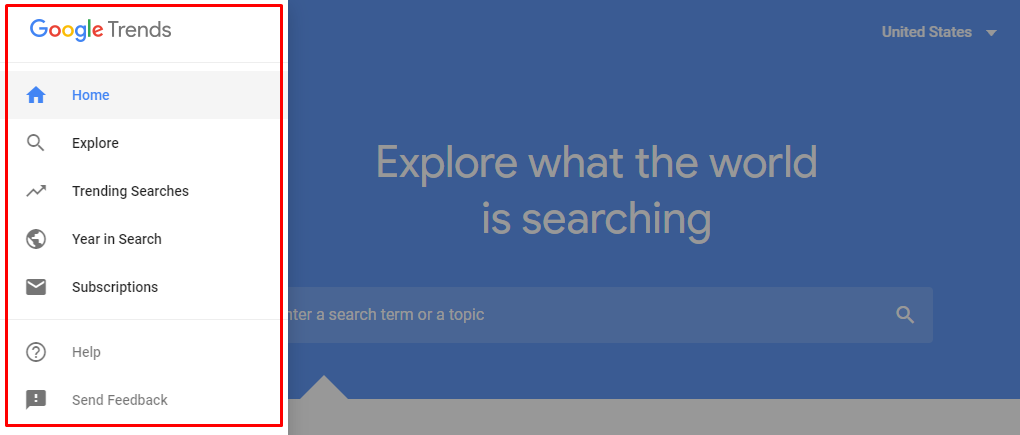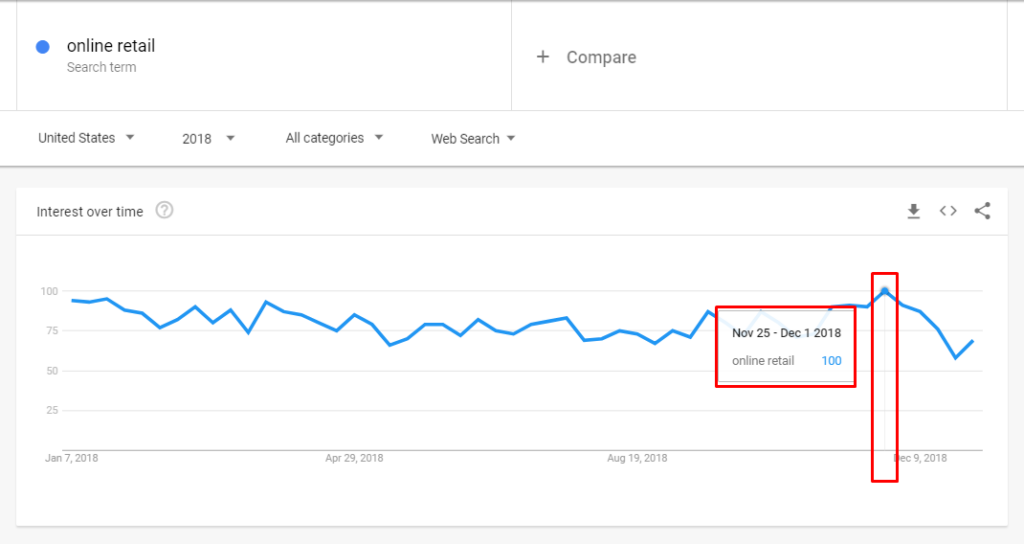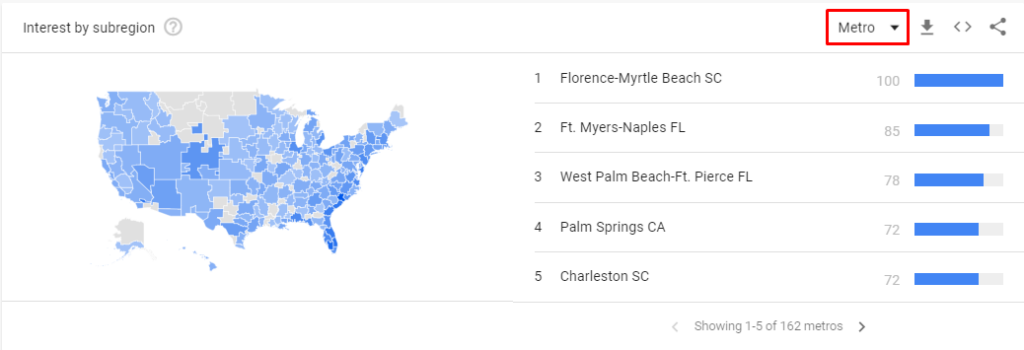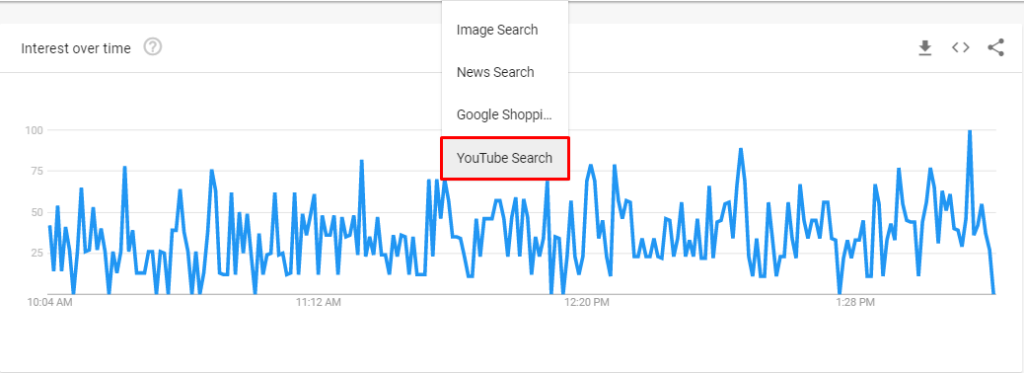-
 8 min. read
8 min. read
-
 Trevin Shirey
Trevin Shirey VP of Marketing
VP of Marketing
- Trevin serves as the VP of Marketing at WebFX. He has worked on over 450 marketing campaigns and has been building websites for over 25 years. His work has been featured by Search Engine Land, USA Today, Fast Company and Inc. Read his review of working with WebFX for the last 15 years.
Every day, Google sees billions of searches and pumps out even more answers. Wouldn’t it be handy to have a clear view of these search patterns and learn the population’s most nagging questions and topics? With Google Search Trends, you can.
The platform’s diagrams and data can inform your search engine optimization (SEO) strategy and keep you current on in-demand keywords in your line of work. Google Search Trends helps you track timeless keywords for your pages, as well as hot trends that will pass. It’s an essential tool if you want to climb the rankings on Google and drive qualified traffic to your site.
Are you interested in finding SEO services to help your business earn top, lucrative rankings in search results? Contact WebFX online or call us at 888-601-5359 to speak to an expert and learn more about SEO.
What is Google Search Trends?
Google Search Trends is a free tool that displays the relative popularity of queries, according to the total amount of searches on Google in a specific time and place. It takes real-time and historical data samples from Google searches in a given period and puts it in readable formats for users.
The tool has sections for exploring your chosen terms, examining trending searches, and looking over a specific year’s leading search topic history — reaching back to 2001.  The Explore section is the most customizable and informative for business owners and marketers. It offers a chart that organizes the interest over time with scores from 0 to 100, as well as regional and related query references. To stay in the know about important industry news, you can subscribe to topics, region-based searches, and trending searches on Google Search Trends.
The Explore section is the most customizable and informative for business owners and marketers. It offers a chart that organizes the interest over time with scores from 0 to 100, as well as regional and related query references. To stay in the know about important industry news, you can subscribe to topics, region-based searches, and trending searches on Google Search Trends.
 This resource provides useful insights for your SEO efforts, and analyzing the data can shape your understanding of valuable keywords and successful content.
This resource provides useful insights for your SEO efforts, and analyzing the data can shape your understanding of valuable keywords and successful content.
What can Google Search Trends do for your SEO strategy?
In the mountain of available SEO tools, what makes Google Search Trends a worthwhile addition to your strategy? One convincing benefit is that Google, the most used search engine worldwide, is collecting and showcasing these results. Since Google processes the most search queries and presides as the top search engine, using their tools is a reliable way to grasp authentic information and comprehensive data.
From keyword research to content marketing, you have a unique window into the habits of searchers. You get to study the leading keywords on Google and apply it to your SEO optimization. Let’s unpack how to check Google Search Trends in order to bring your marketing campaign to the next level and spark more revenue for your business.
1. Leverage relevant keywords
Keyword research is the cornerstone of SEO, and tools like Google Search Trends make selecting the right terms seamless. At its heart, this trend tool is an indispensable keyword research resource. The relative search volume shows how many people tend to plug in that query.
The adjustable segments — country, time, industry category, and search type — can narrow your search. For example, when you want to isolate the search trends to your particular industry, like finance, you can navigate through the dropdown menu to your desired field. The more specific you make your search parameters, the more you can decipher the search intent.
SEO depends on matching the search intent of your audience. Search intent is the expectation behind someone’s search. When a person searches “notebook,” do they want to buy a notebook or know about the movie “The Notebook”?
SEO search intent is all about figuring out people’s ultimate need when they enter a query. Google Trends connects crucial times and categories to direct you toward an accurate interpretation of keywords.
If one of your keywords is “online retail,” it might not be surprising to you that in the U.S. during 2018, its interest over time peaked at the beginning of December in time for holiday shopping.
 Ecommerce stores can pay attention to timely changes like this to extend appealing content. Whether you choose to create new content or optimize old content, you can elevate user experience when you know what users commonly look for when searching online.
Ecommerce stores can pay attention to timely changes like this to extend appealing content. Whether you choose to create new content or optimize old content, you can elevate user experience when you know what users commonly look for when searching online.
2. Explore popular related topics and queries
As you plan for ongoing content creation, it’s helpful to gather related subjects and keywords. Google Search Trends pairs your term with similar terms that have caught the public’s eye. You can look at the rising related topics and queries, which predicts profitable upcoming keywords in the same category as your original term.
If you sort by top related terms, it gives you an overview of the best performing keywords during your chosen period. This sets you up to either get a head start on emerging topics or compete for coveted keywords.
3. Determine benefits for locations
The map on Google Search Trends Explore isn’t just country-specific — it also breaks down interest in subregions, metros, and cities. This means you can see how marketable your services are in your target cities and states. Location trends can affect your local SEO efforts.
If you want to rank for searches that include location specifics and Google Maps listings — like “Italian restaurants near me” — local SEO is a natural approach.  You can identify the areas that succeed best for your ideal keywords and gauge your competition. If you don’t have a physical storefront, or you can perform services from anywhere, modify location-specific pages for the most engaged cities.
You can identify the areas that succeed best for your ideal keywords and gauge your competition. If you don’t have a physical storefront, or you can perform services from anywhere, modify location-specific pages for the most engaged cities.
4. Watch patterns in interest over time
Without context, spikes in popularity can seem like a fluke — but it still makes plenty of people jump on the bandwagon for surging keywords. However, if you expect a one-trick keyword to keep generating traffic, you throw off your SEO strategy. For instance, vegetable suppliers could notice the popularity of “romaine lettuce” in 2018 and invest time into optimizing for this keyword.
However, the E. coli outbreak and romaine lettuce recall made the widespread discussion on this keyword understandable. The decrease in interest after the event also makes the keyword no longer attractive.
 If you see a decrease in interest for keywords related to your services, inspect industry events and trends to hone in on the cause. You can use this tool to shed light on abrupt changes in traffic for your site. If events, news stories, or fads shoot the interest in a keyword up, you can dig into the related keywords and context to inform your campaign.
If you see a decrease in interest for keywords related to your services, inspect industry events and trends to hone in on the cause. You can use this tool to shed light on abrupt changes in traffic for your site. If events, news stories, or fads shoot the interest in a keyword up, you can dig into the related keywords and context to inform your campaign.
Especially if you’re aiming for evergreen content, find consistent interest rather than intense surges. Alternatively, you can use fluctuating rises in interest to gain visibility. Cover a trending topic in your content to address current issues and build a reputation as a source for fresh, relevant material.
5. Find possibilities for seasonal content
Due to Google Search Trends’ emphasis on time periods, it can guide your seasonal content creation. Catering to seasonal needs can change your content schedule, and this tool can pinpoint the highest interest on Google over the years. You can line up content that deals with popular holidays, events, or weather, based on these results.
Providing content that coincides with users’ searches is an art form year-round, but you can anticipate their pain points and present your content as the solution if you know what they’ll be entering into Google. If you want to rank for “pool accessories,” optimizing your site for the summer is necessary. You can start arranging your page with keyword distribution and backlinks so that it’s ready from June to August.
Bonus: Check out video prospects on Google Trends’ YouTube.
Written content isn’t the only useful form of seasonal content.
Videos powerfully communicate your business’ values and services. An important feature in Google Trends lets you see YouTube video search trends. Under the search type dropdown options, you can discover the advantage of different keywords in YouTube searches.
This tool will help you create YouTube ads that inspire visitors. YouTube is a subsidiary of Google, and you can sift through the search query trends for sought-after videos. Among the search spaces of image, news, and shopping, YouTube is essential for video content marketing.
If your business is considering putting out video content, this can show how fitting this platform can be based on the interest level. 
Generate revenue with WebFX
Google Search Trends strengthens your SEO approach, so you can go forward with confidence that your keywords and content will usher in conversions and revenue. Beginning at rates between $900-$1000, you can have access to a team of SEO experts that can boost your business even further.
WebFX has generated 24 million leads in the last five years, and we can propel traffic to your pages with our skillful SEO services. Contact us online today or call us at 888-601-5359 to start ranking higher and driving more revenue.
-
 Trevin serves as the VP of Marketing at WebFX. He has worked on over 450 marketing campaigns and has been building websites for over 25 years. His work has been featured by Search Engine Land, USA Today, Fast Company and Inc. Read his review of working with WebFX for the last 15 years.
Trevin serves as the VP of Marketing at WebFX. He has worked on over 450 marketing campaigns and has been building websites for over 25 years. His work has been featured by Search Engine Land, USA Today, Fast Company and Inc. Read his review of working with WebFX for the last 15 years. -

WebFX is a full-service marketing agency with 1,100+ client reviews and a 4.9-star rating on Clutch! Find out how our expert team and revenue-accelerating tech can drive results for you! Learn more
Try our free Marketing Calculator
Craft a tailored online marketing strategy! Utilize our free Internet marketing calculator for a custom plan based on your location, reach, timeframe, and budget.
Plan Your Marketing Budget

SEO Success with KOA

Proven Marketing Strategies
Try our free Marketing Calculator
Craft a tailored online marketing strategy! Utilize our free Internet marketing calculator for a custom plan based on your location, reach, timeframe, and budget.
Plan Your Marketing Budget
What to read next





